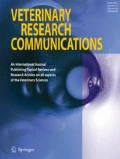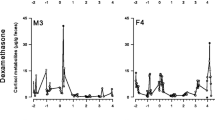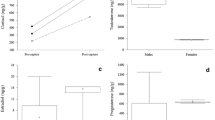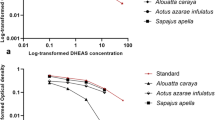Abstract
Glucocorticoids or their metabolites can be measured in several body fluids or excreta, including plasma, saliva, urine and faeces. In recent years the measurement of glucocorticoid metabolites (GCMs) in faeces has gained increasing attention, because of its suitability for wild populations. In horses, however, the group-specific enzyme immunoassay described so far has a limited practicability due to its complex extraction procedure. Therefore, we tested the applicability of other enzyme immunoassays for glucocorticoid metabolites. The present study clearly proved that an enzyme immunoassay (EIA) for 11-oxoaetiocholanolone using 11-oxoaetiocholanolone-17-CMO: BSA (3α,11-oxo-A EIA) as antigen showed high amounts of immunoreactive substances. Therefore it was possible to use just a small amount of the supernatant of a methanolic suspension of faeces. The results correlated well with the already described method for measuring GCMs in horse faeces, i.e. analysing the samples with an EIA after a two step clean up procedure of the samples (Merl et al. 2000). In addition, the 3α,11-oxo-A EIA has the advantage of providing a bigger difference between baseline values and peak values after ACTH stimulation. The new assay increased the accuracy of the test, lowered the expenses per sample, and storing samples at room temperature after collection was less critical than with other assays investigated in our study. This is a big advantage both in the field of wildlife management of equids and in the field of equestrian sports and it shows the importance of choosing an assay which is in good accordance with the metabolites excreted in a given species.




Similar content being viewed by others
References
Alexander S.L. and Irvine C.H.G. (1998) The effect of social stress on adrenal axis activity in horses: the importance of monitoring corticosteroid-binding globulin capacity. J Endocrinol 157:425–432.
Bosson C.O., Palme R., Boonstra R. (2009) Assessment of the stress response in columbian ground squirrels: laboratory and field validation of an enzyme immunoassay for fecal cortisol metabolites. Physiol Biochem Zool 82:291–301.
Cannon W.B. (1935) Stresses and strains of homeostasis. Am J Med Sci 189:1–14.
Ganswindt A., Palme R., Heistermann M., Borragan S., Hodges J.K. (2003) Non-invasive assessment of adrenocortical function in the male African elephant (Loxodonta Africana) and its relation to musth. Gen Comp Endocrinol 134:156–166.
Gorgasser I., Tichy A., Palme R. (2007) Faecal cortisol metabolites in Quarter Horses during initial training under field conditions. Vet Med Austria, Wien Tierärztl Mschr 94:226–230.
Heistermann M., Palme R., Ganswindt A. (2006) Comparison of different enzymeimmunoassays for the assessment of adrenocortical activity in primates based on fecal analysis. Am J Primatol 68:257–273.
Hopster H., van der Werf J.T.N., Erkens J.H.F., Blokhuis H.J. (1999) Effects of repeated jugular puncture on plasma cortisol concentration in loose-housed dairy cows. J Anim Sci 77:708–714.
Kohen F., Bauminger S., Lindner H.R. (1975) Preparation of antigenic steroid-protein conjugates. In: Cameron E.H.D., Hillier S.G., Griffiths K. (eds) Steroid Immunoassays. Omega Publishing, Cardiff, pp 11–32.
Matteri R.L., Carroll J.A., Dyer D.J. (2000) Neuroendocrine responses to stress. In: Moberg J.P. and Mench J.A. (eds) The Biology of Animal Stress. CABI Publishing, Oxford, pp 43–76.
Merl S., Scherzer S., Palme R., Möstl E. (2000) Pain causes increased concentrations of glucocorticoid metabolites in equine faeces. J Equine Vet Sci 20:586–590.
Moons C., Heleski C.R., Leece C.M., Zanella A.J. (2002) Conflicting results in the association between plasma and salivary cortisol levels in foals. Harvemeyer Foundation Workshop, Iceland.
Möstl E. and Palme R. (2002) Hormones as indicators of stress. Domest Anim Endocrinol 23:67–74.
Möstl E., Messmann S., Bagu E., Robia C., Palme R. (1999) Measurement of glucocorticoid metabolite concentration in faeces of domestic livestock. J Vet Med A 46:621–631.
Möstl E., Maggs J.L., Schrötter G., Besenfelder U., Palme R. (2002) Measurement of cortisol metabolites in faeces of ruminants. Vet Res Commun 26:127–139.
Niswender G.D. and Midgley A.R.Jr. (1970) In: Peron F.G. and Caldwell B.V. (eds) Immunologic Methods in Steroid Determination. Appleton-Century-Crofts, New York, pp 149–173.
Palme R. and Möstl E. (1997) Measurement of cortisol metabolites in faeces of sheep as a parameter of cortisol concentration in blood. Int J Mamm Biol 62:192–197.
Palme R., Fischer P., Schildorfer H., Ismail M.N. (1996) Excretion of 14C-steroid hormones via faeces and urine in domestic livestock. Anim Reprod Sci 43:43–63.
Sapolsky R.M., Romero L.M., Munck A.U. (2000) How do glucocorticoids influence stress responses? Integrating permissive, suppressive, stimulatory and preparative actions. Endocr Rev 21:55–89.
Selye H.A. (1936) A syndrome produced by diverse nocuous agents. Nature 138:32–33.
Touma C. and Palme R. (2005) Measuring fecal glucocorticoid metabolites in mammals and birds: the importance of validation. Ann N Y Acad Sci 1046:54–74.
Wingfield J.C. and Ramenofsky M. (1999) Hormones and the behavioural ecology of stress. In: Balm P.H.M. (ed) Stress Physiology in Animals. Sheffield Academic Press, pp 1–51.
Acknowledgments
We thank Jürgen Heinze for helpful suggestions, Sandra Hake-Paulus, Petra Kölle, Anika Pachten, Bettina Wollanke (LMU Munich) and Hans-Peter Remler (LVFZ Haupt- und Landgestüt Schwaiganger Pferdehaltung) for assistance with conducting the experiment, Alexandra Kuchar and Andreas Trindl for technical assistance in the laboratory, and Henning Thies for language corrections. Horses have been provided by the LMU Munich and the LVFZ Haupt- und Landgestüt Schwaiganger Pferdehaltung. The study was supported by an Excellence grant of the Universität Bayern e.V. and an HWP II grant of the University of Regensburg.
Author information
Authors and Affiliations
Corresponding author
Rights and permissions
About this article
Cite this article
Flauger, B., Krueger, K., Gerhards, H. et al. Simplified method to measure glucocorticoid metabolites in faeces of horses. Vet Res Commun 34, 185–195 (2010). https://doi.org/10.1007/s11259-010-9344-y
Accepted:
Published:
Issue Date:
DOI: https://doi.org/10.1007/s11259-010-9344-y




